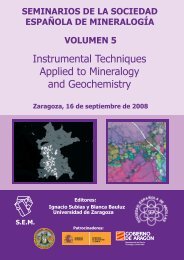XVI Reunión CientÃfica de la Sociedad Española de Arcillas - Libro ...
XVI Reunión CientÃfica de la Sociedad Española de Arcillas - Libro ...
XVI Reunión CientÃfica de la Sociedad Española de Arcillas - Libro ...
You also want an ePaper? Increase the reach of your titles
YUMPU automatically turns print PDFs into web optimized ePapers that Google loves.
Martins V et al. / Comunicaciones SEA 2001 – Baeza (Jaén)<br />
Results and discussion<br />
14 C datations provi<strong>de</strong>d the following ages: 1045± 95 yr BP for <strong>la</strong>yer 39-40 cm,<br />
2380 ± 80 yr BP for <strong>la</strong>yer 69-70 cm, 4340 ± 100 yr BP for <strong>la</strong>yer 134-135 cm.<br />
Therefore, core KSGX 40 contains sediments which were <strong>de</strong>posited during the<br />
<strong>la</strong>st 5000 yr BP, approximately.<br />
As general features, sediment grain size <strong>de</strong>creases progressively from the<br />
basis to the top of the core and illite is the predominant c<strong>la</strong>y mineral, followed by<br />
kaolinite, smectite and chlorite. The two <strong>la</strong>st c<strong>la</strong>y minerals referred to p<strong>la</strong>y an<br />
important role because their contents vary significantly and in opposite way along<br />
the studied core.<br />
Taking into consi<strong>de</strong>ration both silt and c<strong>la</strong>y fractions mineralogical<br />
composition estimation along the sedimentary column as well as grain size<br />
distribution and the total content of benthic foraminifera species re<strong>la</strong>ted to<br />
temperate waters it was possible to establish the following zonography in the core:<br />
1. In the section 164-100 cm the assemb<strong>la</strong>ge illite + kaolinite + smectite +<br />
chlorite could be recor<strong>de</strong>d which indicates temperate and wet climates; from the<br />
basis to the top of this section, a <strong>de</strong>crease of smectite content associated to an<br />
increase of chlorite content was recor<strong>de</strong>d; the re<strong>la</strong>tive abundance of benthic<br />
foraminifera corresponding to prevailing temperate-cold climates increases in<br />
some levels of this section; the higher abundance of these species found around<br />
the <strong>de</strong>pths of 110 cm (~3500 yr BP), 115 cm (~4000 yr BP),140 cm (~4500 yr BP)<br />
and 160 cm (~5000 yr BP) and the higher sand fraction content existent in the<br />
sediment below the <strong>de</strong>pth of 100 cm (pointing out to an higher supply of<br />
sediments to the shelf by river floods during rainy periods), allows us to assume<br />
that this section of the studied core corresponds to a period of transition from the<br />
At<strong>la</strong>ntic climate (cold and wet) to the Sub-Boreal climate (warm and dry) during<br />
which several cooler episo<strong>de</strong>s did take p<strong>la</strong>ce. It is worth to mention that between













